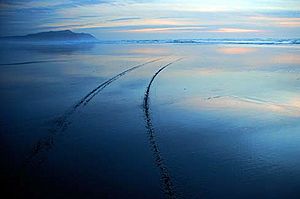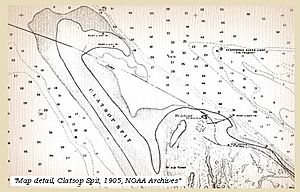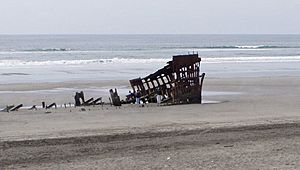Clatsop Spit facts for kids
Clatsop Spit is a huge sandy area on the Pacific coast in northwest Oregon. It's located near Astoria, right where the mighty Columbia River meets the ocean.
This giant sand spit was created over thousands of years. After the last ice age ended about 8,500 years ago, the ocean level rose. The Columbia River then carried tons of sand and mud, called sediment, to the coast. The wind and waves worked together to shape this sediment into the large sandy plain we see today. When people talk about Clatsop Spit, they usually mean the northern part, which is bordered by the Pacific Ocean on one side and the Columbia River on the other. Long ago, it was even called Clatsop Sands.
Shipwrecks and the "Graveyard of the Pacific"
The waters around Clatsop Spit were very dangerous for ships. Many shipwrecks happened here. Because of all these shipwrecks, the mouth of the Columbia River is often called the "Graveyard of the Pacific."
One famous shipwreck was the paddle steamer General Warren in 1852. Other ships that met their end here include the schooner Rambler in 1859 and the barque Leonese in 1860. In 1906, the bark Peter Iredale also ran aground. Its remains can still be seen on the beach today. Experts believe that since the 1800s, over 2,000 ships have been lost in this area.
How Clatsop Spit Was Formed

About 8,500 years ago, after the last ice age, the sea level along the coast reached its current height. Strong seasonal winds then started moving sand from the Columbia River. In winter, the sand went north to Washington beaches. But in summer, it was pushed south to Oregon's Clatsop Spit.
This natural process helped the sandy beaches grow over time. However, this fast growth is slowing down. Many dams have been built on the Columbia River. These dams now trap much of the sand and mud before it can reach the coast.
When the tide is out, winds blow sand from the exposed beaches inland. This created huge sand dunes in the past. But in the 1930s, people planted grass and shrubs to stop the sand from moving. Now, plants cover and hold the sand in place. The dunes are no longer constantly shifting with the wind. Much of this original dune area is now known as Clatsop Plains.
Today, Clatsop Spit is part of Fort Stevens State Park. It's a great place to visit and learn about its unique history and geology.



